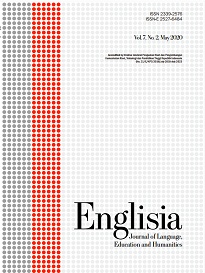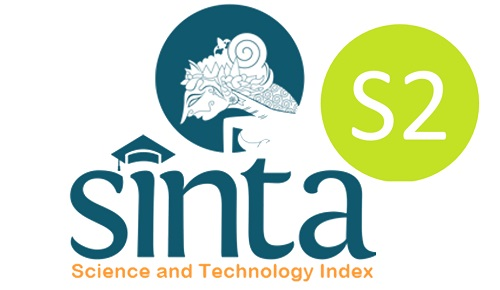An analysis of speech act of Omar Mukhtar's utterances in lion of the desert movie
DOI:
https://doi.org/10.22373/ej.v7i2.6358Keywords:
speech act, omar mukhtar, lion of the desert movieAbstract
Movies are brilliant choices to be subjects of discourse analysis since they bear resemblance to real-life phenomena. Lion of The Desert is one of the movies that actualizes the use of the English language as the dialogue and presents Islamic historical values as its content. Among a myriad of sub-disciplines of discourse analysis, this paper attempts to investigate speech act phenomena in the utterances of Omar Mukhtar, the main character of the movie. The discourse analysis is conducted on his utterances in order to extract the types of speech acts he employs. Primary data sources include the movie video file and its script. We execute several procedural steps of extracting the data, commencing with watching the movie while reading its script; re-watching it to identify the aspects like voice, intonation, and mimics; interpreting, and classifying the types of speech acts in accordance with the classification procedure of John R. Searle’s speech act theory. The findings revealed four types of speech acts, namely, representative, directive, commissive, and expressive, being identified and classified in Mukhtar’s utterances. The most frequently used type of speech act was representative, which is performed in 56 utterances, followed by a directive act which appears in 53 utterances. Commissive and expressive speech acts emerge in 9 and 7 utterances respectively.
Downloads
References
Alston, W. P. (2000). Illocutionary acts and sentence meaning. Ithaca: Cornell University Press.
Anscombe, G. E. M. (1957). Intention. Oxford: Basic Blackwell.
Austin, J. L., & Urmson, J. O. (1962). How to do things with words. The William James lectures delivered at Harvard University in 1955. Oxford: Clarendon Press.
Bayat, N. (2013). A study on the use of speech acts. Procedia-Social and Behavioral Sciences, 70, 213–221.
Blum-Kulka, S., & Olshtain, E. (1984). Requests and apologies: A cross-cultural study of speech act realization patterns (CCSARP). Applied Linguistics, 5(3), 196–213.
Brisset, N. (2018). Models as speech acts: the telling case of financial models. Journal of Economic Methodology, 25(1), 21–41.
Brown, P., & Levinson, S. (1987). Politeness: Some universals in language usage. Cambridge: Cambridge University Press.
Canby, V. (1981, April 17). "Lion of the desert," Bedouin Vs. Mussolini. The New York Times. Retrieved from https://www.nytimes.com/1981/04/17/movies/lion-of-the-desert-bedouin-vs-mussolini.html. Accessed on March 24, 2020.
Cohen, A.D., Olshtain, E. (1993). The production of speech acts by EFL learners. TESOL Quarterly, 27(1), 33-56.
Creswell, J. W. (2012). Educational research planning, conducting and evaluating quantitative and qualitative research (4th ed.). Lincoln: Pearson Education.
Esposito, J. L. (2003). The Oxford dictionary of Islam. New York: Oxford University Press.
Gee, J. P. (2011). An introduction to discourse analysis: Theory and method (3rd ed.). New York: Routledge.
Ghanbaran, S., Rahimi, M., & Rasekh, A. E. (2014). Intensifiers in Persian discourse: Apology and compliment speech acts in focus. Procedia Science and Behavioral Science, 98, 542–551.
Glare, P. G. W. (Ed.). (2012). Oxford latin dictionary (2nd ed.). Oxford: Oxford University Press.
Habiburrahim, H., Rahmiati, Z., Muluk, S., Akmal, S., & Aziz, Z. A. (2020). Language,
identity, and ideology: Analysing discourse in Aceh sharia law implementation. Indonesian Journal of Applied Linguistics, 9(3), 599-607.
Hafner, K. (2018, September 17). Umar Mukhtar – Löwe der Wüste. Der tagesspiegel. Retrieved from http://islamicnews.de/2018/09/17/umar-mukhtar-loewe-der-wueste/. Accessed on March 24, 2020.
Hatakeyama, Y. (2011). What do students listen to and why?: Exploratory analyses of students' listening journals. Language Research Bulletin, 26, 1–12.
Kemptner, M. (2017). Perlokutionäre sprechakte in deutschsprachigen Tages-und Wochenzeitungen. Universität Wien.
Kissine, M. (2013). From utterances to speech acts. New York: Cambridge University Press.
Mey, J. L. (2001). Pragmatics: an introduction (2nd ed.). Oxford: Blackwell Publishing.
Nuridin, W. (2018). Developing pragmatic competence of Indonesian EFL learners through teaching speech acts of orals and written complaints. Englisia: Journal of Language, Education, and Humanities, 6(1), 27–34.
Rahman, M. A. (2004). Discourse analysis. Banda Aceh: Ar-Raniry Press.
Sadock, J. M. (1974). Toward a linguistic theory of speech acts. New York: Academic Press.
Searle, J. R. (1976). A classification of illocutionary acts. Language in Society, 5(1).
Searle, J. R. (1979). Expression and meaning studies in the theory of speech act. New York: Cambridge University Press.
Shanti, A., Lee, K. W., & Lajium, D. (2017). Discourse analysis as a qualitative approach to study information sharing practice in Malaysian board forums. International Journal on E-Learning Practices (IJELP).
Simona, S., & Dejica-Cartis, D. (2015). Speech acts in written advertisements: Identification, classification and analysis. Procedia-Social and Behavioral Sciences, 192(24), 234–239.
Tabar, M. S., & Malek, L. A. (2013). Delving into speech act of requests of Iranian Turkish informants. Procedia-Social and Behavioral Sciences, 70, 1724–1731.
Tunzelmann, A. (2011). Lion of the desert roars for Libya's rebels. The Guardian. Retrieved from https://www.theguardian.com/film/filmblog/2011/jun/30/lion-of-the-desert-libya-gaddafi. Accessed on March 24, 2020.
Wæver, O. (1989). Security, the speech act: Analysing the politics of a word. Research Training Seminar, Sostrup Manor. Jerussalem/Tel Aviv.
Walter, C. (2016). The financial logos: The framing of financial decision-making by mathematical modelling. Research in International Business and Finance, 37, 597–604.
Wertz, F. J., Charmaz, K., McMullen, L. M., Josselson, R., Anderson, R., & McSpadden, E. (2011). Five ways of doing qualitative analysis: Phenomenological psychology, grounded theory, discourse analysis, narrative research, and intuitive inquiry. New York: The Guilford Press.
Winograd, T., & Flores, F. (1986). Understanding computers and cognition: A new foundation for design. Norwood: Ablex Publishing Corporation.
Yule, G. (2017). The study of language (6th ed.). New York: Cambridge University Press.
Downloads
Published
Issue
Section
License
Proposed Policy for Journals That Offer Open Access
Authors who publish with Englisia journal agree to the following terms:
- Authors retain copyright and grant the journal right of first publication with the work simultaneously licensed under a Creative Commons Attribution License that allows others to share the work with an acknowledgement of the work's authorship and initial publication in this journal.
- Authors are able to enter into separate, additional contractual arrangements for the non-exclusive distribution of the journal's published version of the work (e.g., post it to an institutional repository or publish it in a book), with an acknowledgement of its initial publication in this journal.
- Authors are permitted and encouraged to post their work online (e.g., in institutional repositories or on their website) prior to and during the submission process, as it can lead to productive exchanges, as well as earlier and greater citation of published work (See The Effect of Open Access).









